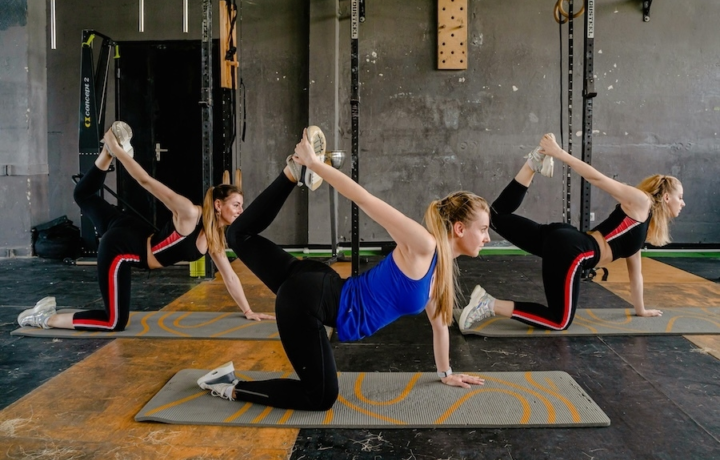Exercise
Iron Cross Stretch

Iron Cross Stretch
How to Perform
- Lie flat on your back with your arms extended out to the sides in a T position, palms facing up.
- Bend your knees and place your feet flat on the floor, hip-width apart.
- Keeping your upper back and shoulders pressed into the floor, lower both knees to the right side while exhaling slowly.
- Allow your head to turn gently to the left as your knees drop to the right, maintaining contact between both shoulders and the floor.
- Hold this stretched position for 20-30 seconds while taking deep, controlled breaths.
- Engage your core muscles and use them to slowly return your knees to the center starting position while inhaling.
- Repeat the movement by lowering both knees to the left side while turning your head to the right.
- Complete the exercise by returning to center and extending your legs flat on the floor.
Important information
- Keep both shoulders firmly pressed to the floor throughout the entire movement to maximize the rotational stretch.
- Move slowly and with control, never forcing the stretch beyond your comfortable range of motion.
- If you experience any sharp pain in your lower back or neck, reduce the range of motion or place a pillow between your knees.
- For a deeper stretch, extend your legs straight instead of keeping knees bent, but only if you can maintain proper form.

Iron Cross Stretch
Exercise Details
Primary Muscles
Muscle Groups
Mechanic
Risk Areas
Built for progress
Take the guesswork out of training
Create personalized AI-powered workout plans that evolve with you. Train smarter, track every rep and keep moving forward, one workout at a time.






The Iron Cross Stretch offers a wonderfully effective way to open up the chest and shoulders, making it an excellent addition to any fitness routine, especially for beginners looking to enhance their mobility. This fundamental stretch primarily targets the pectoral muscles and anterior deltoids (front shoulders), which tend to become tight from daily activities like computer work, driving, or even from chest-focused workouts. As a recovery tool, the Iron Cross Stretch helps counteract the natural forward-rounding posture many of us develop throughout the day. By creating a gentle but effective stretch across the chest wall, it helps release tension in these chronically shortened muscles and can significantly improve posture over time when practiced regularly.
What makes this stretch particularly valuable is its versatility within a workout routine. When used during a warm-up, it helps prepare the chest and shoulder muscles for more intense activity by increasing blood flow and creating mobility in the shoulder joint. As part of a cool-down protocol, it assists in reducing post-workout muscle soreness and helps maintain long-term flexibility in these important upper body areas. The beauty of the Iron Cross lies in its simplicity yet profound effect on upper body mobility. Regular practice can help correct muscular imbalances between the chest and upper back, potentially reducing the risk of shoulder injuries.
For those who spend long hours at a desk, this stretch can provide immediate relief from the sensation of tightness across the front of the shoulders. While gentle enough for beginners, the Iron Cross Stretch offers scalable intensity, allowing you to adjust the degree of stretch based on your current flexibility level. Consistent incorporation of this stretch into your mobility work can lead to noticeable improvements in shoulder range of motion, making everyday movements feel more fluid and comfortable while enhancing performance in various upper body exercises.
FAQ - Iron Cross Stretch
The Iron Cross Stretch primarily targets the pectoral muscles (chest) and anterior deltoids (front shoulders). It also creates a beneficial stretch through the biceps and helps open up the entire anterior chain that tends to tighten during daily activities.
Lie on your back with arms extended out to the sides in a T-position. Keeping your shoulders flat on the ground, bend one knee and rotate it across your body toward the opposite side of the floor. Hold for 20-30 seconds per side while maintaining controlled breathing throughout the movement.
The Iron Cross is generally safe for most people, but those with existing shoulder injuries should approach with caution. Start with a smaller range of motion and avoid forcing the stretch if you feel sharp pain rather than the normal stretching sensation in the chest and shoulders.
For optimal mobility benefits, perform the Iron Cross Stretch 3-5 times per week. You can include it in both your warm-up routine (holding for 10-15 seconds) and cool-down sessions (holding for 20-30 seconds) to improve posture and shoulder mobility over time.
The most common errors include shrugging your shoulders toward your ears, overarching your lower back to compensate for limited shoulder mobility, and stretching too aggressively. Focus on quality over intensity, keep your core engaged to protect your spine, and remember that consistent, gentle stretching yields better results than occasional forceful attempts.







